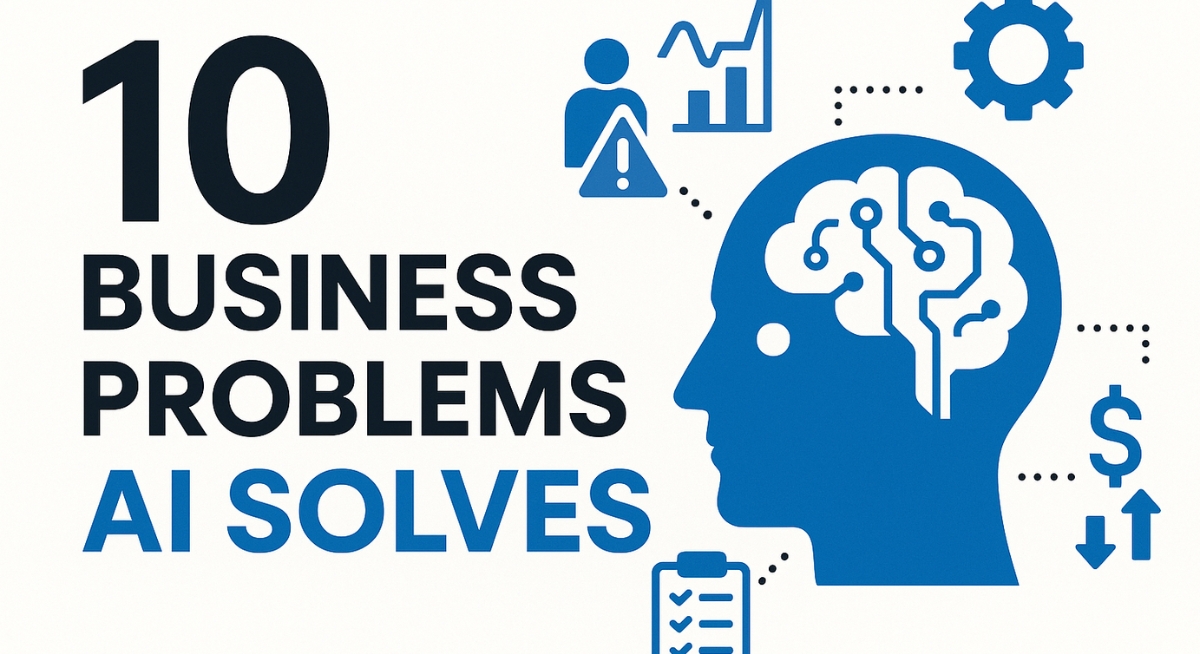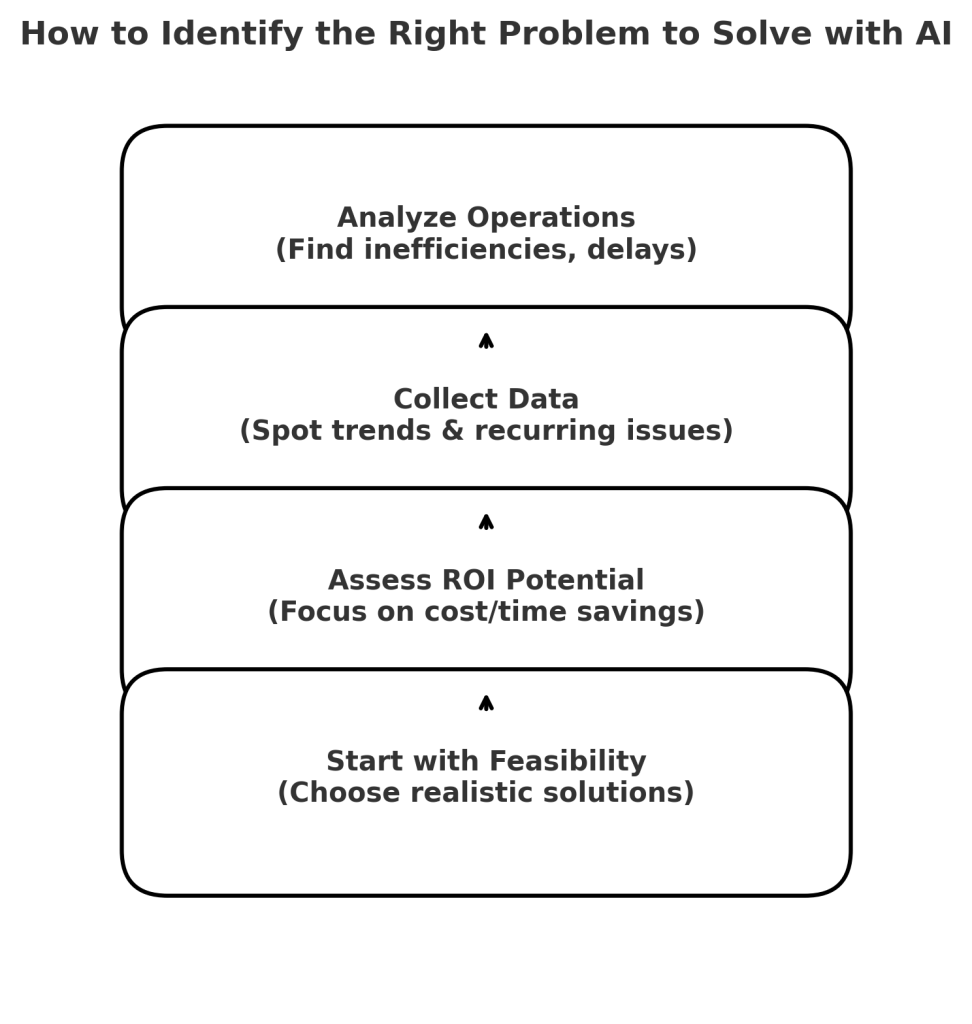
Staying competitive in today’s fast-paced business world means solving problems faster and smarter than ever before. That’s where artificial intelligence (AI) comes in. Far beyond being just a buzzword, AI has become a strategic business tool—helping organizations cut costs, increase efficiency, and deliver better customer experiences.
Whether you’re struggling with poor sales forecasting, high employee workload, or supply chain disruptions, there’s an AI-powered solution that can help. In this article, we’ll explore the top 10 business problems you can solve with AI, along with real-world examples of companies that turned challenges into growth opportunities using automation, predictive analytics, and intelligent decision-making tools.
Artificial intelligence (AI) refers to technologies that allow machines to mimic human intelligence. This includes machine learning, natural language processing (NLP), predictive analytics, and automation tools.
AI is no longer experimental; it’s a mainstream driver of business efficiency. From automating repetitive tasks to enabling smarter decision-making, businesses today are using AI solutions transforming business to tackle complex challenges that were once expensive and time-consuming.
📊 According to Gartner, 80% of enterprises will use AI technologies by 2030, highlighting how essential it has become in achieving competitive advantage.
Businesses face increasing pressure to innovate, cut costs, and meet rising customer expectations. AI helps by:
By adopting AI, businesses can move from reactive problem-solving to proactive growth strategies, ensuring they stay relevant in a digital-first economy.
Before implementing AI, businesses should carefully choose where it adds the most value. Here’s how:

Once you pinpoint the right problem AI can solve, you can design tailored solutions that deliver measurable results.
Problem: Long response times and inconsistent support frustrate customers.
AI Solution: Chatbots, virtual assistants (e.g., ChatGPT, Drift), and sentiment analysis tools handle FAQs 24/7.
Example: Retailers using AI-powered chatbots cut response times by 60%. In healthcare, AI triage assistants reduced patient wait times by 25%.
If you don’t have in-house expertise, you can browse Gignaati verified AI gigs to hire professionals who can build and maintain your AI-powered customer service solutions.
Problem: Inaccurate predictions lead to missed revenue opportunities.
AI Solution: Predictive analytics tools like Salesforce Einstein, Zoho Analytics analyze past data and customer behavior.
Example: A B2B distributor aligned inventory with demand using AI, cutting overstock by 20%. In retail, AI-driven forecasts improved seasonal planning accuracy.
Problem: Low ROI from poorly targeted campaigns.
AI Solution: AI-driven personalization and HubSpot AI, Persado, Mailchimp AI optimize targeting and messaging.
Example: A fashion e-commerce brand used AI personalization to lift click-through rates by 40%.
Problem: Manual workflows slow productivity.
AI Solution: Automation platforms like UiPath, Automation Anywhere streamline repetitive tasks.
Example: A logistics firm automated shipment scheduling and cut processing time by 50%.
Problem: Growing fraud and cyberattack risks.
AI Solution: AI anomaly detection with Darktrace, IBM QRadar identifies threats in real time.
Example: A global bank reduced fraudulent transactions by 35% using AI-powered monitoring.
Problem: Employees waste time on repetitive, low-value tasks.
AI Solution: AI scheduling assistants, HR automation tools like HireVue AI, Workday free up time.
Example: HR teams using AI candidate screening shortened hiring cycles by 40%. In finance, AI reduced reporting workload by half.
Problem: Overstocking or stockouts reduce revenue.
AI Solution: AI-powered demand forecasting tools like Blue Yonder, E2open optimize stock levels.
Example: E-commerce businesses reduced carrying costs by 25% while ensuring product availability. In automotive supply chains, AI prevented costly stockouts.
Problem: Leaders rely on outdated or incomplete data.
AI Solution: AI dashboards like Tableau AI, Power BI Copilot provide real-time insights.
Example: A manufacturing firm used AI analytics to cut production downtime by 15%.
Problem: Losing customers faster than gaining them.
AI Solution: Predictive churn models with Amplitude AI, Pega Systems identify at-risk clients.
Example: A telecom provider reduced churn by 20% using AI-driven retention offers. A SaaS firm cut cancellations by 18% with personalized retention campaigns.
Problem: Delays and inefficiencies hurt delivery performance.
AI Solution: Predictive logistics with FourKites, Llamasoft anticipate risks.
Example: A manufacturer improved delivery times by 25% using AI logistics forecasting. In food supply chains, AI minimized spoilage with real-time routing.

By addressing these challenges proactively, companies can maximize AI’s impact.
AI is no longer futuristic—it’s a practical tool solving real business problems today. From customer support automation to fraud detection and supply chain optimization, AI is driving measurable business growth across industries.
The key is starting small: identify a high-ROI problem, implement AI, measure results, and scale. Businesses that adopt AI now will stay ahead of the competition tomorrow.👉 Ready to explore how AI can solve your biggest challenges? Don’t wait to fall behind. Hire AI experts on Gignaati’s AI services marketplace and implement solutions that cut costs, boost efficiency, and transform your business.
AI helps with customer service, sales forecasting, marketing optimization, fraud detection, inventory management, decision-making, and supply chain disruptions.
By using chatbots, sentiment analysis, and virtual assistants, AI reduces response times, resolves queries instantly, and lowers support costs.
Repetitive and data-heavy tasks like invoice processing, churn prediction, and inventory optimization are easiest to automate.
Yes. Cloud-based AI tools like HubSpot AI, Zoho, and ChatGPT-powered assistants make AI accessible to small businesses without big investments.
Risks include poor data quality, integration issues, employee resistance, and bias in AI models. Mitigation requires clean data and trusted vendors.
AI tools analyze datasets, detect patterns, and generate real-time insights, enabling faster, more accurate, data-driven decisions.
Explore Gignaati.com – where top AI innovators showcase verified AI agents for real-world solutions.
© 2025 Gignaati is a product of Smartians.ai. All rights reserved.